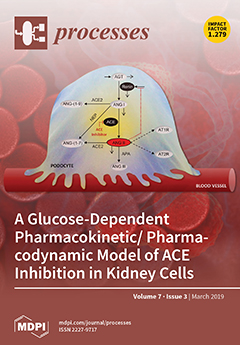Carbonaceous adsorbents with both high sulfur capacity and easy regeneration are required for flue gas desulfurization. A hierarchical structure is desirable for SO
2 removal, since the micropores are beneficial for SO
2 adsorption, while the mesopore networks facilitate gas diffusion and end-product
[...] Read more.
Carbonaceous adsorbents with both high sulfur capacity and easy regeneration are required for flue gas desulfurization. A hierarchical structure is desirable for SO
2 removal, since the micropores are beneficial for SO
2 adsorption, while the mesopore networks facilitate gas diffusion and end-product H
2SO
4 storage. Herein, an ordered hierarchical porous carbon was synthesized via a soft-template method and subsequent activation, used in SO
2 removal, and compared with coal-based activated carbon, which also had a hierarchical pore configuration. The more detailed, abundant micropores created in CO
2 activation, especially the ultramicropores (d < 0.7 nm), are essential in enhancing the SO
2 adsorption and the reserves rather than the pore patterns. While O
2 and H
2O participate in the reaction, the hierarchical porous carbon with ordered mesopores greatly improves SO
2 removal dynamics and sulfur capacity, as this interconnecting pore pattern facilitates H
2SO
4 transport from micropores to mesopores, releasing the SO
2 adsorption space. Additionally, the water-washing regeneration performances of the two types of adsorbents were comparatively determined and provide a new insight into the mass-transfer resistance in the pore structure. The ordered hierarchical carbon promoted H
2SO
4 desorption efficiency and cycled SO
2 adsorption–desorption performance, further indicating that interconnecting micro- and mesopores facilitated the diffusion of adsorbates.
Full article





